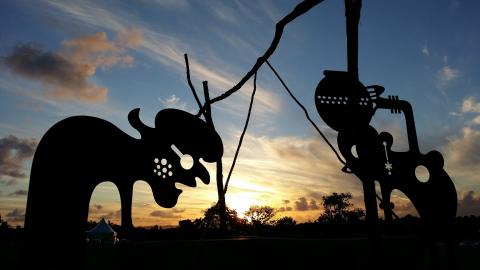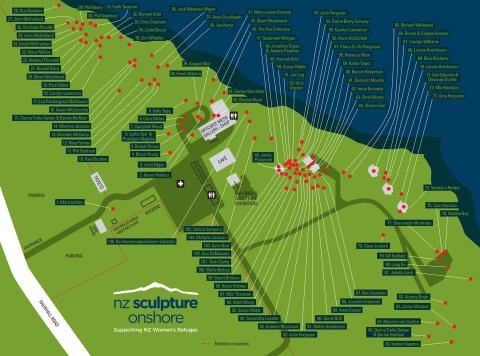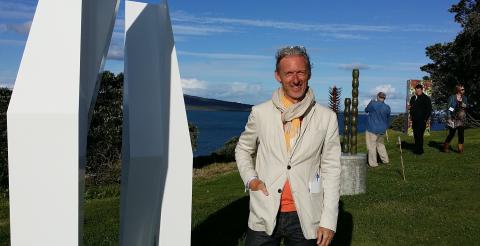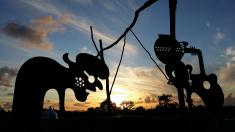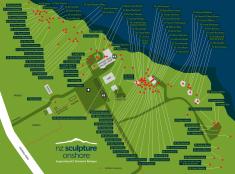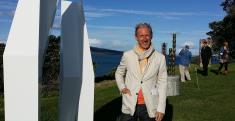10th Sculpture OnShore
6-16 November 2014, Auckland NZ
Looking out, looking back and looking ahead
Curated by Rob Garrett
The NZ Sculpture OnShore outdoor sculpture exhibition and biennial sculpture trail was established by a group of North Shore art lovers in 1994 to raise funds for NZ Women's Refuges, it has grown in size a popularity and in 2014 staged its 10th edition of the exhibition.
NZ Sculpture OnShore is now the longest-running outdoor sculpture exhibition in the country; and this type of exhibition, along with its close relatives, the various sculpture trails and sculpture parks throughout New Zealand, may set this country apart globally. As I travel internationally I am often asked by my overseas colleagues “what is it with the numerous outdoor sculpture exhibitions and sculpture trails?” Nowhere else that I know of, has so many exhibitions and trails of this kind. I will not presume to explain the origins and causes of this phenomenon of the past 20 years, but it does point to a healthy creative sector; indicates there is enthusiasm and interest by New Zealand audiences for contemporary art outside the gallery; and perhaps reflects New Zealanders' love of the outdoors.
Over the course of its ten biennials, Sculpture OnShore has evolved from an initial focus on garden sculpture, ceramics and glass into a comprehensive survey of the variety, breadth and energy of the country’s contemporary sculpture practices. Embracing the way artists define sculpture in the new century we aim to show the full diversity of art forms, notwithstanding the challenges and limitations of showing in the outdoors! This year, even video and performance make their appearance.
Alongside the experimental and conceptual, the site-specific and the issue-based projects, we are also proud to show work by our leading sculptors of stone, wood, glass, ceramics and bronze. Thus the exhibition demonstrates the variety and quality of the two broad strands of sculptural practice that persist and thrive in New Zealand: conceptual and formal.
For us, the exhibition site – Fort Takapuna – is almost as important as the art works. Admittedly, many artists have chosen to respond to some aspect of the site’s distinctive history, symbolic significance or natural characteristics, and this has been encouraged. However, when I say the site is important to us, I do not mean it only in this way. I believe that all the selected art works should be placed so that we gain an amplified appreciation of both the location and the art work; that each should work on the other, through their juxtaposition, so that we gain something more than just the sum of their parts. Thus, through the site we may see the art work in a fresh light; and through the art work we may appreciate the site in a newly memorable way. This is our hope.
Thinking about how to present a number of the abstract works this year I was reminded of the early 20th century works of the Surrealist Max Ernst. He made a series of “enchanted forest” paintings in which he experimented with a new, almost sculptural technique involving densely textured grattage (scraping forms and textures into the wet surface of the paint) and frottage (taking a rubbing from an uneven surface) surfaces to evoke his vision of Oceania as “savage and impenetrable … ferocious, fervent, and likeable, without yesterday or tomorrow.”
In an homage to Ernst, but also as if to challenge the romanticism of his European view of Oceania, I have tightly clustered a selection of abstract and semi-figurative works on the northern-most cliff-top as if to call out a new song across the waves. Looking out towards the entry to the Hauraki Gulf at a place that was once more densely wooded, hopefully this year’s sculptures face the world with a sense of New World confidence, expectation and optimism.
Look-outs and optimism are needed close to home too. Today, we have to look out for each other in a variety of ways, and one among them is the raison d’être of the Sculpture OnShore exhibition: to help those who help our most vulnerable women and children. As we all know, this is a watch that falls to all of us, not just NGOs and Government agencies. Watching out for each other is the necessary work of friends, family members, work colleagues and neighbours if we are to turn the awful domestic violence statistics of our Oceanic paradise around.
Children and Sculpture OnShore
Since 2008 NZ Sculpture OnShore has been forging a closer relationship with the unique "Children's Sculpture @ the Fort" exhibition, integrating this into the overall exhibition; and parallel to this, developing a range of programmes specifically for our young visitors.
Children's Sculpture Exhibition: an exhibition of artwork by children from fifteen schools and art groups around Auckland.
Education programme: an opportunity for out-of-classroom learning for children aged 8-14 focused on a visit to the exhibition. Alongside this opportunity to experience major works of outdoor art, each group is provided with a professionally designed education pack to make the most of the visit back in the classroom.
Kidszone: a fun activity-based programme that gives children the opportunity to make art and participate in a group art project. Kidszone operates during both weekends of the exhibition.
In 2012 we extended our children's programme by offering artist workshops in some of the schools contributing to the "Children's Sculpture at the Fort" exhibition. Artists were selected from those who were exhibiting in the 2012 NZ Sculpture OnShore exhibition. The video above gives a snap-shot of this initiative.
In 2012 these activities were led by a wonderful group of volunteers: Rhonwen Dewar, Tania Stewart, Zoe Hoeberigs and Val Hoeberigs.
